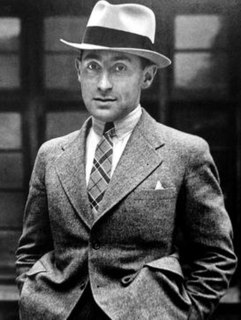Top 32 Quotes & Sayings by Alfred Eisenstaedt
Explore popular quotes and sayings by an American photographer Alfred Eisenstaedt.
Last updated on December 3, 2024.
My style hasn't changed much in all these sixty years. I still use, most of the time, existing light and try not to push people around. I have to be as much a diplomat as a photographer. People don't often take me seriously because I carry so little equipment and make so little fuss... I never carried a lot of equipment. My motto has always been, "Keep it simple".
The way I would describe a pictorial is that it is a picture that makes everybody say ‘Aaaaah,’ with five vowels when they see it. It is something you would like to hang on the wall. The french word ‘photogenique’ defines it better than anything in English. It is a picture which must have quality, drama, and it must, in addition, be as good technically as you can possible make it.
With photography, everything is in the eye and these days I feel young photographers are missing the point a bit. People always ask about cameras but it doesn't matter what camera you have. You can have the most modern camera in the world but if you don't have an eye, the camera is worthless. Young people know more about modern cameras and lighting than I do. When I started out in photography I didn't own an exposure meter - I couldn't , they didn't exist! I had to guess.
I don’t use an exposure meter. My personal advice is: Spend the money you would put into such an instrument for film. Buy yards of film, miles of it. Buy all the film you can get your hands on. And then experiment with it.That is the only way to be successful in photography. Test, try, experiment, feel your way along. It is the experience, not technique, which counts in camera work first of all. If you get the feel of photography, you can take fifteen pictures while one of your opponents is trying out his exposure meter.
Today's photographers think differently. Many can't see real light anymore. They think only in terms of strobe - sure, it all looks beautiful but it's not really seeing. If you have the eyes to see it, the nuances of light are already there on the subject's face. If your thinking is confined to strobe light sources, your palette becomes very mean - which is the reason I photograph only in available light.
It's important to understand it's OK to control the subject. If most editorial stories were photographed just as they are, editors would end up throwing most in the waste basket. You have to work hard at making an editorial picture. You need to re-stage things, rearrange things so that they work for the story, with truth and without lying.
Another picture I hope to be remembered by is this one of the drum major rehearsing at the University of Michigan. It was early in this morning, and I saw a little boy running after him, all the faculty children in the playing field ran after the boy, and I ran after them. This is a completely spontaneous, unstaged picture.
People will never understand the patience a photographer requires to make a great photograph, all they see is the end result. I can stand in front of a leaf with a dew drop, or a rain drop, and stay there for ages just waiting for the right moment. Sure, people think I'm crazy, but who cares? I see more than they do!




















